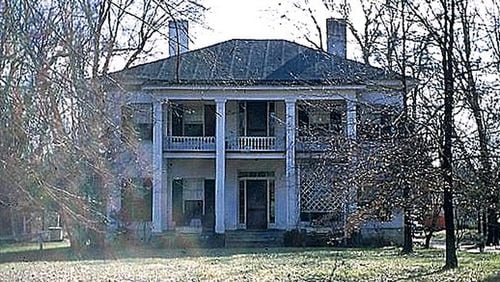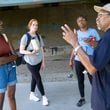The Wilson house is no more. The antebellum structure that withstood war, storms and the passage of decades has succumbed to an implacable foe: neglect.
The mansion on Fairburn road was flattened earlier this month. The city of Atlanta issued a permit for its demolition. The house, listed on the National Register of Historic Places, is now a pile of broken stone, dried timbers and nails forged before the Civil War.
The demolition, say preservationists, came as a surprise. They thought the mansion’s remains would be stabilized and left standing as a reminder of Atlanta’s past.
Now, a neighborhood planning group proposes turning the spot into a garden. It would feature reminders of a fine old home where soldiers in blue once bivouacked before pushing toward the sea.
The demolition capped a process that began in April, when a city inspector visited the empty house. The structure, he noted, was little more than a ruin, overrun with weeds and missing stones. The sun shone through its partially collapsed roof.
City records compiled since that visit show the house consistently failed to comply with minimum safety codes. In August, Atlanta's Office of Planning issued an order that the mansion be demolished.
“We did find it to be unsafe and structurally unsound,” said Jewanna Gaither, a city public information officer.
Eric Riesenberg complied with the demolition order — reluctantly. He's a managing member of Arberg Properties LLC, an Atlanta property-management firm that owns the house. The structure is part of a 75-acre tract that includes the Atlanta Center for Medical Research, formerly a hospital. Arberg Properties bought the land in 2013.
“Nobody was taking care of it, and there was no option to save it even after we purchased it,” Riesenberg, who’s also CEO of the research center, said in an interview earlier this month. “We tried.”
He talked to engineers, who said the building was on the verge of collapse. Riesenberg said he also talked with preservationists about saving the structure. “They all said, ‘We don’t have the funds,’” Reisenberg said.
The Atlanta Preservation Center promised $1,500 to help raise money to stabilize the walls, said Boyd Coons, the organization's executive director. But that was nowhere near enough to do the job.
The Wilson house, Coons said, was but one of three Atlanta antebellum homes still remaining on the sites where they had been built. The others are the L.P. Grant mansion in Grant Park and Meadow Nook in East Lake.
“This is quite an enormous loss,” he said.
The ruins, on the 500 block of Fairburn Road in southwest Atlanta, are now are ringed with silt fences. They encircle mounds of rubble. Two massive trash containers await the arrival of heavy equipment to begin removing the remains of a house that still looms large in Dr. Thomas Guffin’s memory. His great-great-grandfather, William Asbury Wilson, built it.
When he was a boy, said Guffin, he regularly visited his grandparents in the white-column house southwest of downtown.The home, built between 1856-59, was steeped in family lore.
Now 60, Guffin recalls the imprint of horses' hooves hidden under carpet on the living room floor; during the Civil War Battle of Utoy Creek, Yankee officers kept mounts there. The front door featured a patched hole, a long-ago reminder that a soldier — Yankee or Confederate, no one knew — fired at the house. A column bore the carved declaration, "Death to all traitors" — a statement, perhaps, left by a northern partisan.
And this: “It had a wonderful banister,” Guffin said. “You could slide down it. That was really cool.”
But banisters and historic floorboards need upkeep; when the family sold the house to nearby Holy Family Hospital in the 1960s, it was with the understanding that the hospital would look after the structure, Guffin said. Hospital administrators ordered the columns’ removal and renovated the building to house nuns. That altered the home’s graceful symmetry.
When Southwest Community Hospital over from Holy Family, the building fell into neglect. As one year followed the next, the house looked ever more dilapidated. When the hospital closed, that left no one to tend to the old mansion.
“They had a house they didn’t want,” Guffiin said. “It was kind of a white elephant for them.”
It was an eyesore to passersby, said Kathy Crawford, who chairs the executive board of Neighborhood Planning Unit H. The organization, or NPU, advises the mayor’s office and the City Council on zoning and other local issues in the Fairburn Road area. Twenty-five NPUs operate across the city.
The NPU, she said, wanted to stabilize the walls, as the preservation center suggested. “Then we talked to an engineer,” she said. “He told us to tear it down. …We had to redo our plans.”
Now, she said, the NPU wants to create a “green space,” with some benches for meditation. Members hope to preserve some artifacts from the rubble and put them on display.
A possible artifact: the staircase that reached from the ground floor to the bedrooms above — a spot where a child once slid down a banister with a big grin on his face.
About the Author






